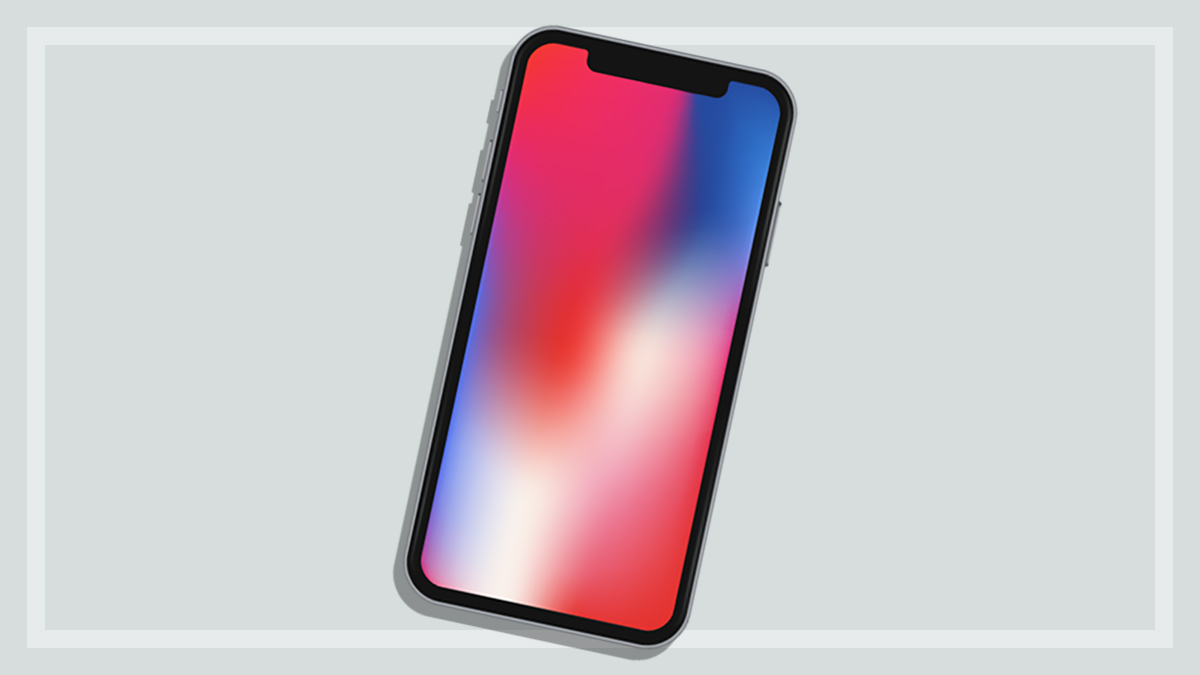Get our independent lab tests, expert reviews and honest advice.
Apple iPhone 15 and 15 Pro review
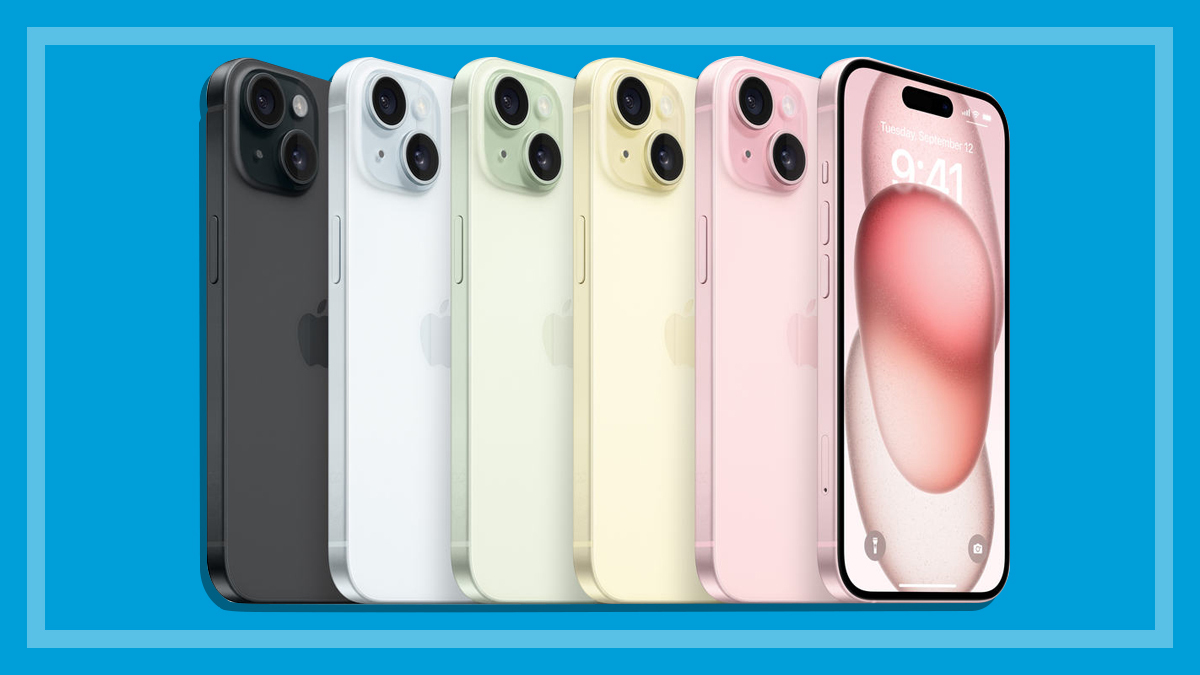
CHOICE verdict
For some, the challenge with Apple iPhones is less about whether to get one and more about which one to get. If you’re already an iPhone user and have anything older than an iPhone 12 (as well as the spare cash), any model in the iPhone 15 series is worth the upgrade. As far as connectivity goes, the move to USB-C finally brings Apple’s smartphone into line with almost every other smartphone and will reduce your cable clutter in the process. From there it’s a decision about whether you want a larger screen (iPhone 15 Plus or iPhone 15 Pro Max), whether you want a top-of-the-line camera (iPhone 15 Pro and iPhone 15 Pro Max) and whether you want to spend between $1499 and $2899 for the privilege.
Price: From $1499
Contact:
apple.com/au/iphone/On this page:
- Apple iPhone 15 and 15 Plus specs
- Apple iPhone 15 Pro and 15 Pro Max specs
- USB-C: It's kind of a big thing
- Dynamic Island
- Camera performance
- Battery performance
- Upgrade or wait?
An Apple iPhone release used to be a really big deal. Since the first iPhone was announced by Steve Jobs in 2007, it was one product – either the 3, 4 or 5 – and people lined up around the corner of Apple stores all over the world to be one of the first to get their hands on the shiny new object.
Today, there are eight iPhone models to choose from, with various storage capacities and colours on offer. The iPhone 15 marks the latest series, with two 6.1-inch display models (iPhone 15 and iPhone 15 Pro) and two 6.7-inch variants (iPhone 15 Plus and iPhone 15 Pro Max). Apple seems to have officially declared 6.1 inches as the smallest smartphone size with the SE and Mini models getting no updates for 2023.
The iPhone 15 range is similar in look, features and functionality, with the more expensive Pro version including a faster processor, better camera and larger capacity battery, while the Pro Max supports USB 3 for much faster file transfers (if you have the right cables).
Related Apple reviews
- Apple iPhone 14 and 14 Pro
- Apple Watch Series 9
- Apple iPad 10
- Apple iPad Pro M2 12.9-inch
- Apple iPad Air
- Apple MacBook Air 15-inch
- Apple MacBook Pro M2 14-inch
- Apple MacBook Air M2 13-inch
- Apple MacBook Pro 14-inch
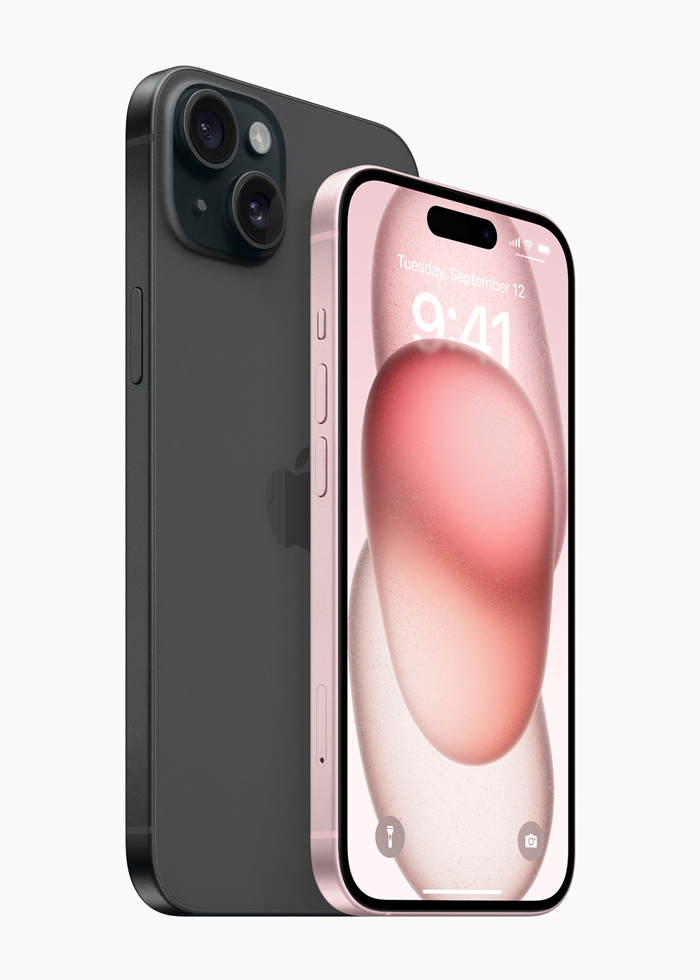
Apple iPhone 15 and 15 Plus specs
- Display: Super Retina XDR OLED display, 2556 x 1179 pixels (iPhone 15) / 2796 x 1290 pixels (iPhone 15 Plus); 1000 nits max brightness (typical), 1600 nits peak
brightness (HDR).
- Screen size: 6.1-inch (iPhone 15) / 6.7-inch (iPhone 15 Plus).
- Weight: 171 grams (iPhone 15) / 201 grams (iPhone 15 Plus).
- Battery life (video playback): Up to 20 hours (iPhone 15) / up to 26 hours (iPhone 15 Plus).
- Up to 50% charge in 30 minutes with a 20W adapter or higher (five minutes longer for the iPhone 15 Plus).
- MagSafe and Qi wireless charging and charging via USB to a computer system or power adapter.
- Rear camera: Dual 48MP camera system (Main) and (12MP Ultra Wide), 2x optical zoom out, 4K video recording at 24fps, 25fps, 30fps or 60fps.
- Selfie camera: 12 MP photos, 4K video recording at 24fps, 25fps, 30fps or 60fps.
- Network: Wi-Fi 6 (802.11ax), mobile network support 3/4/5G.
- Bluetooth: 5.3, NFC with reader mode.
- Processor: A16 Bionic chip.
- RAM: 6GB.
- Protection: IP68 dust- and water-resistant.
- USB-C supports USB 2.
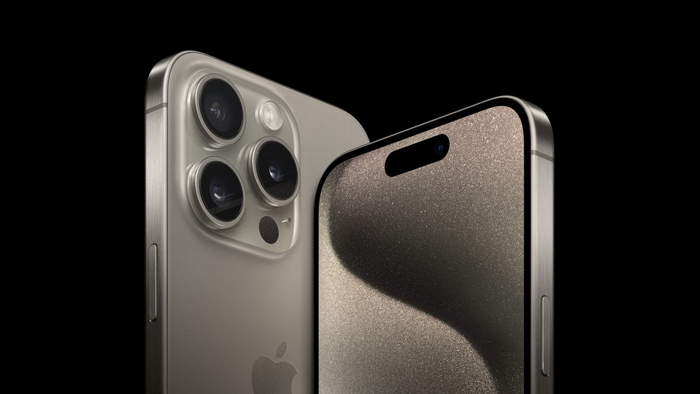
Apple iPhone 15 Pro and 15 Pro Max specs
- Display: Super Retina XDR OLED display, 2556 x 1179 pixels (iPhone 15 Pro) / 2796 x 1290 pixels (iPhone 15 Pro Max); 460 pixels per inch HDR support; 1000 nits max brightness (typical), 2000 nits peak brightness (outdoor).
- Screen size: 6.1-inch (iPhone 15 Pro) / 6.7-inch (iPhone 15 Pro Max).
- Weight: 187 grams (iPhone 15 Pro) / 221 grams (iPhone 15 Pro Max).
- Battery life (video playback): Up to 23 hours (iPhone 15 Pro) / up to 25 hours (iPhone 15 Pro Max).
- Up to 50% charge in 30 minutes with a 20W adapter or higher (5 minutes longer for the iPhone 15 Pro Max).
- MagSafe and Qi wireless charging and charging via USB to a computer system or power adapter.
- Rear camera: 48MP camera system (Main), 3x optical zoom iPhone 15 Pro / 5x optical zoom iPhone 15 Pro Max. Main, ultrawide and telephoto.
- 4K video recording at 24fps, 25fps, 30fps or 60fps.
- Selfie camera: 12MP photos, 4K video recording at 24fps, 25fps, 30fps or 60fps.
- Network: Wi-Fi 6E (802.11ax), mobile network support 3/4/5G.
- Bluetooth: 5.3, NFC with reader mode.
- Processor: A17 Bionic chip.
- RAM: 8GB.
- Protection: IP68 dust- and water-resistant.
- USB-C connection, supports USB 3 speeds up to 10Gbps with the appropriate cable (not included in box).
USB-C: It’s kind of a big thing
The move from Lightning to USB-C connection for the iPhone 15 may be the most significant move by Apple in recent years as it finally brings the tech giant’s smartphone in line with the rest of the industry.
This means no more hunting around for proprietary cables when travelling, greater compatibility with Android smartphone users and also better synergy with most Apple products (iMac, MacBook, iPad) already using a USB-C connection.
The full potential of the USB-C format is unlocked with the iPhone 15 Pro and Pro Max with support for USB 3 allowing file transfer speeds of up to 10Gbps, which is significantly faster than the USB 2 speeds available with the iPhone 15 and 15 Plus. However, if you do want this speed bump, you need to buy an extra cable as the one in the box for the 15 Pro and 15 Pro Max is USB 2.
The move from Lightning to USB-C connection may be the most significant move by Apple in recent years
As with the previous iPhone 14 Pro series, the Pro variant of the iPhone 15 supports ProMotion technology with a higher 120Hz refresh rate which means scrolling and moving content around the screen is smoother.
Also, the small notch introduced with the iPhone 14 Pro is now called Dynamic Island and is available on all iPhone 15 models and can be used to display information like music details, incoming calls or a timer.
All iPhone 15 models support fast wireless technologies, with 5G mobile network support and Wi-Fi 6, while the Pro gets Wi-Fi 6E. There’s also dual SIM support where you can have one physical SIM card and an eSIM or two eSIMs.
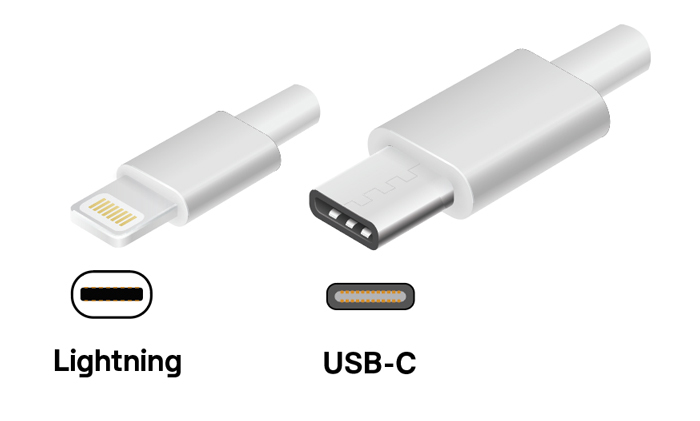
Dynamic Island
The island feature adds some neat UI changes such as showing the source and sound that’s being emitted from a background app like Spotify or YouTube. It also shows call duration with a small audio wave bar that interacts with the sound.
Its main advantage is providing a better idea of what’s happening in the background when using multiple apps. When playing audio through Spotify for example, you can press on the island to show a small widget/pop-up screen which gives you control of the source. This includes skip, play/pause and audio outputs.
The small notch introduced with the iPhone 14 Pro is now called Dynamic Island and can be used to display things like music details, incoming calls or a timer
When using the AirPods Pro 2, it’ll show the battery levels of the headphones and also the case when it drops below a certain battery level, indicating it may be time to charge the case. There are a range of specific games and apps that support the Dynamic Island but when using the phone day to day it’s more of a nice to have rather than a reason to upgrade.
Ideally it would’ve been better for the design team to focus on making the inevitable camera blackout area as small as possible (as is the case on many Android smartphones) rather than making it a feature, as we found the notch can still be distracting when watching videos in landscape mode.
Camera performance
Both the iPhone 15 and iPhone 15 Pro come with a 48MP main camera (wide) and a 12MP ultra-wide camera lens, while the iPhone 15 Pro includes an additional 12MP telephoto lens. The main camera also has an improved sensor-shift image stabilisation system which can be very useful for one-handed photography and video capture.
The autofocus for the front camera is very good with the telephoto camera of the iPhone 15 Pro delivering noticeable improvements in image quality at high zoom factors over the iPhone 15. The optical zoom ranges from 2x for the 15 and 15 Plus to 3x for the 15 Pro and 5x for the 15 Pro Max.
The overall image quality for all the iPhone 15 models remains very good and all are IP certified for full submersion in water up to six metres deep for up to 30 minutes.
The front-facing (selfie) camera isn’t as powerful as the main camera on either the iPhone 15 or iPhone 15 Pro, but it’s still better than most and, as with almost all front-facing cameras, is limited to the smaller sensor and unable to perform quite as well in darker environments.
Battery performance
Battery performance claims for the iPhone 15 Pro Max are at the top of the scale with up to 29 hours of video playback on a single charge, 20 hours for the iPhone 15 Pro and 15 Plus, and up to 16 hours for the iPhone 15.
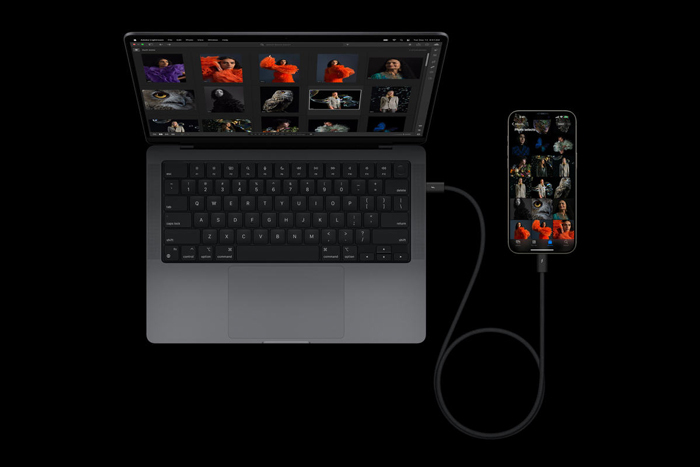
Upgrade or wait?
The latest iPhone 15 and iPhone 15 Pro from Apple are the most powerfully featured Apple smartphones yet, but for the most part it’s an incremental upgrade over the iPhone 14 series except for one thing: USB-C. This in itself could be the reason you consider upgrading if you work in a wider Android or PC environment where USB-C connectivity would be seen as a big enough advantage to make the move.
Owners of Apple iPhone 11 smartphones and older will also get the benefit of mobile network coverage with 5G and a significant jump in performance, battery life and camera quality. But remember, there’ll be a lot of initial pain in getting rid of all the Lightning cables and accessories.
Apple iPhone support ending for older models
Apple tends to support its devices for longer periods than most other smartphone manufacturers, but all good things must come to an end.
While the ending of support often attracts criticism, it must be noted that the newest iPhones Apple has put on the ‘not supported list’ are the iPhone 8, 8 Plus and iPhone X, which was released at the end of 2017. So in a way it highlights the durability of these devices if they’re still being used in the wild.
Not supported doesn’t mean that they’ll no longer work as smartphones, only that they’ll no longer be able to support the latest Apple iOS 17 (which offers new features like a lock screen setup and improvements to messages, mail and the Apple Maps app). There’ll also be no guarantee of ongoing security and performance updates. The oldest iPhone that will be able to run iOS 17 will be the iPhone XR.

